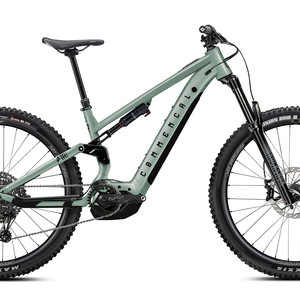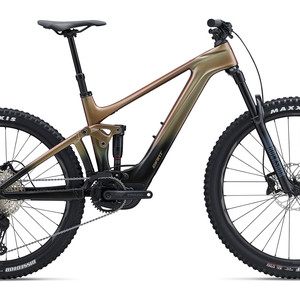2025 Marin Rift Zone EL 1 E-Bike
| Where To Buy | |||
|---|---|---|---|
Free shipping on orders over $50 (continental U.S. only).
International shipping available. Some exclusions apply. |
|||
Free shipping on orders over $50 (continental U.S. only).
International shipping available. Some exclusions apply. |
|||

Marin is no stranger to the e-MTB market and just a few short years ago in 2021, their affordable, simple, fun Alpine Trail E2 was our favorite e-sled of the year. Not one to upset the apple cart, Marin continues their tradition of making bikes that won't break the bank while remaining enjoyable on the trail with the release of the Rift Zone EL line. The "Rifty" EL series use the lauded Bosch SX drive system with a 400wh CompactTube battery and is offered in three different builds. Prices are $6,999, $5,999 or $4,799, and when Marin reached out about a review, we asked for the budget-friendly EL 1 to throw a leg over. An e-MTB with an up-to-date system and sub-$5,000 price tag will always be intriguing to us.

Highlights
- Full alloy frame
- 29-inch wheels front and rear
- 150mm front travel, 140mm rear travel
- Bosch Performance Line SX drive system, 600w max output, 55nm torque
- 400wh removable battery (optional upgrade, 250wh Powermore external battery)
- Adjustable headtube angle (-.5, 0,+.5 degrees)
- Marzocchi Bomber suspension
- Shimano CUES 10-speed drivetrain (11-48t cassette)
- e.thirteen 160mm cranks with 34t chainring
- TRP Slate EVO brakes, 203mm rotors
- Maxxis EXO+ tires - 2.4 Minion DHF Maxxgrip (front), 2.4 Forekaster MaxxTerra (rear)
- Sizes: S, M (tested), L, XL
- Weight: 46 pounds (20.86kg), with pedals, size Medium tested
- Price: $4,799 USD
Pros
| Cons
|
Overview
We're more than familiar with Marin's linkage-driven single-pivot design they call MultiTrac, as its been a staple of their full-suspension platforms for years. Discussing this new Rift Zone EL (RZEL) with the developers, we'd learned that they partnered with Cass Lab in northern California to get ride data which helped them decide the best shock choices and tunes for the models. Our EL 1 uses Marzocchi Bomber suspension (Z1 fork and Bomber Air Inline shock), while the two higher models use FOX suspension. One thing that instantly caught our eye (and yours if you saw our Instagram post about the bike) was the upside-down shock orientation. Shocks with a piggyback on a RZEL require the inverted position to fit on the bike. If grit and grime entering your shock is a fear, then keep that in mind. Our EL 1 with the inline Bomber shock did not require an upside down position. The bike ships that way, however, and the shock stickers are applied accordingly. After our first ride, we flipped the shock just because we could and would leave it that way.
The rest of the build is is reasonable and generally robust considering the price point of the bike, and the addition of an adjustable head angle headset is a nice touch. Topping off nice touches is the shrink-wrapped rear brake and shifter housing, keeping the cockpit tidy. We all know that the lower the price, the higher the weight and our medium Rift Zone EL 1 pushed a hefty 46 pounds (20.86kg) with pedals. At this weight, you won't get any argument from us if you think this is outside the realm of "light" e-bike, but we were still eager to see how it felt on the trail. The Bosch SX system with its cable-free Bluetooth controller is a favorite of ours at this point in e-history, and Marin has even made the 400wh battery easily removable for those who want to travel with the bike. Marin was quick to point out that the flat area on the downtube, above the motor has a drain port. So while water may be able to run off, dirt may find a home in the pocket. Chainstay protection is hearty and Marin says the downtube/motor guard is a 30% fiberglass-infused nylon to deflect easily while remaining strong. We never struck that area during our test. Cable ports use rubber membranes to seal housing and hoses.

Geometry
We were aboard a medium Rift Zone EL 1 and left the headset in the neutral position. The geometry is quite classic, if not vanilla, and doesn't delve into the realm of super long or super slack, which for our intended use, is something we applaud. Some riders may bemoan the idea that the Rift Zone EL is dual-29-inch wheels only. We are not those riders. The cockpit is par-for-the-course Marin with their short 35mm stem, 780mm, 28mm rise house bars and Marin Grizzly lock-on grips (which had a nice feel to them). 34.9 TranzX seatposts handle dropper duties with size-specific assigments (150mm on small, 170mm on medium and large, 200mm on XL). The dropper lever was one we hadn't used before and though it was plastic, it had a nice feel and action to it.

On the Trail
As the bike showed up, the weather forecast indicated that bigger mountain rides would be shutdown due to snow in a day or two. We unboxed the beast, set up the squish and went straight to the steeps before we'd be relegated to the mellower foothills for months to come. Our hustle paid off and we managed some fun, tech, last tracks aboard the Rift Zone EL 1. On the descents, the bike's weight was never an issue as it felt surprisingly nimble negotiating tighter maneuvers and rock rolls. The performance and 36mm stanchions of the Z1 kept the bike composed well up front, and the Bomber Air Inline shock let us forget we were limited to only 140mm of rear travel. These descents, however, were short and steep, not unrelenting miles of smashing at higher speeds, but the big hits we came upon were handled with aplomb. TRP's Slate EVO brakes with big rotors front and rear did a great job of keeping speed in check, too. Note that the rotors and hubs use the Centerlock rotor mount interface, something Marin has done for years.

We had to fine-tune the CUES 10-speed drivetrain because it was skipping in the middle of the cassette. B-tension adjustment provided the remedy. When climbs became steep, our legs and lungs were alerted of the gear range on the Rift Zone EL. The CUES 10-speed cassette tops out at 48t in the rear, paired with a 34t chainring up front. A lot of "light" e-biking focuses on human and motor power working together more often than all-motor-all-the-time efforts on "big" e-bikes. The blending of gearing, drive system and bike weight on the EL 1 meant that when we'd look down to see if we had a gear or two left before hitting granny on punchy climbs, we were often disappointed. The low-gear limit was maxed out more often than expected. A little poke on the remote into purple or red on the display meant we'd get up the steep sections with additional power assist but we were also sucking more juice than we'd hope for. If steep climbs and covering longer distances are in your future, a new cassette (be mindful you're on an HG freehub body), chainring or an upgrade to the EL 2 or EL 3 should be on your list. We were stoked on the short, 160mm cranks (spec'd on all sizes), allowing us to pedal up and over anything without fear of pedal strikes.

Snow socked in the big hills, but we managed a couple more rides down low. Despite the weight, there was still a playfulness to the Rift Zone EL 1 on faster rolling trails. Compared to a normal trail bike or the 39-pound Norco Fluid VLT we tested (which costs more than 2x the price of the Marin), there was more effort required to move the bike around, but it never felt like a burden. With the Maxxis DHF up front a bit of focus is required when leaning the bike over on harder packed trails as the knob transition zone is quite wide. The 29-inch rear wheel makes for some fine cruising and bump eating. Our local park has a winter trail made entirely out of broken concrete, and it's a great place to see how well a bike rolls through flat, hang-up-type edges. It also features a few plops to flat. The Marin managed to maintain its composure and speed through both scenarios. Despite multiple rim pings on painful cement edges, the tires held air and the rims were round.

What's the Bottom Line?
Marin continues their tradition of fun bicycles through their budget-friendly Rift Zone EL 1. The Bosch SX system, predictable MultiTrac suspension with Marzocchi components all for a good bit under $5,000 make the EL 1 a compelling choice for those wanting a trail-ready e-MTB. As more and more light e-bikes enter the scene with the promise of an experience that mimics that of a regular mountain bike, riders should take the EL 1's portly weight, lowered powered motor and low gearing into consideration. This trio means that a heavier reliance on the motor may be required when steep climbs are on the menu, draining the battery more quickly. With that in mind, however, we'd have no hesitation recommending the Rift Zone EL 1 to an e-curious rider on a budget or someone who's spun hundreds of laps on motorized mountain bicycles of the past. Fun will surely be had leaving plenty of money in the bank for off-road adventures.

For more information, visit marinbikes.com
View key specs, compare e-bikes, and rate the Marin Rift Zone EL models in the Vital MTB Product Guide.
Specifications
Option: Bosch PowerMore range extender, 250 Wh
Rear: Maxxis Forekaster, 3C MaxxTerra compound, EXO+ casing, TR, 29" x 2.4"
Drop: 150mm (SM), 170mm (MD/LG), 200mm (XL)
• Geometry adjustable via modular headset cups and inserts
• Internal cable routing with rubber membrane sealed ports
• SRAM UDH (Universal Derailleur Hanger)
• Power settings customizable via Bosch eBike Flow Mobile App
• Includes 2 A battery charger
• European price: 5399 EUR
• UK price: 4699 GBP
• Canadian price: 6499 CAD
| Where To Buy | |||
|---|---|---|---|
Free shipping on orders over $50 (continental U.S. only).
International shipping available. Some exclusions apply. |
|||
Free shipping on orders over $50 (continental U.S. only).
International shipping available. Some exclusions apply. |
|||













































2 comments
Post a reply to: First Ride Review - $4,799 Rift Zone EL 1 e-MTB